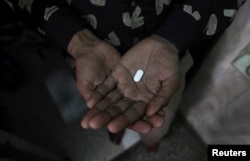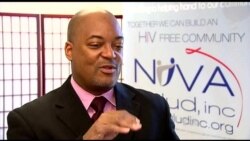An HIV prevention specialist tells a young man in New York: "The test is very simple... there is no blood involved." She hands him a testing swab that he slides along his gums. In 20 minutes, he will know if he has HIV, the virus that causes AIDS.
More than 35 million people around the world are infected with HIV, a disease that is both preventable and treatable. Medical science has come a long way since the days when being HIV positive was an automatic death sentence. Today, if those who have HIV take antiretroviral drugs, the amount of virus in their blood can be so small that it's impossible to infect others.
New pill can prevent infection
In addition, a new pill can prevent people who do not have HIV from getting it. The U.S. Centers for Disease Control and Prevention says when a pre-exposure prophylaxis, or Prep pill, is taken consistently, it cuts the risk of HIV infection in people who are at high risk by up to 92 percent. The agency says Prep has the potential to alter the course of HIV.
Ending the epidemic
The global community has come a long way in the battle against HIV/AIDS. Dr. Anthony Fauci has spent much of his life at the U.S. National Institutes of Health, where he has been working to produce a treatment for the virus and a vaccine to prevent it.
Fauci said anti-retroviral drugs that treat AIDS have changed the course of the disease, even in sub-Saharan Africa, which accounts for 70 percent of the cases of HIV disease.
"If you look at the trajectory of the epidemic, we are on a course towards ending it in the sense of 'as we know it' because we’ve always known it as going up, now it’s flattening off, and now it’s going to start to go down. And we're starting to see that decline," Fauci told VOA.
Fauci warned that we have to be careful of that success because the epidemic is far from over. There are still 37 million people living with HIV, 2 million new infections a year and more than 1 million deaths each year.
UNAIDS reports that new HIV infections have fallen by 35 percent since 2000, but less than half (41%) of infected adults and fewer than one-third of infected children (32%) are receiving antiretroviral therapy.
While the numbers are less than ideal, it's still a huge increase over the numbers of people in treatment five years ago. Another change: because more than 70 percent of pregnant women receive antiretroviral drugs, the number of babies born with HIV has decreased dramatically. That's why Fauci said we can see the light at the end of the tunnel in ending the pandemic.
Population surge will affect HIV
A change in the population may either lead to its decline or cause it to explode again in sub-Saharan Africa.
Dr. Deborah Birx, the Global AIDS Coordinator at the U.S. State Department, said because of a worldwide campaign to reduce poverty and stop the spread of AIDS, there are now 30 to 40 percent more teens and young adults in sub-Saharan Africa than there were at the beginning of the 21st century. And, she told VOA, these young people are at risk for getting HIV.
"Older men are infecting young women, and then those young women five or six years later go on to infect young male partners in their 20s. So if you want to change the total course of the HIV epidemic, you have to get the older men on treatment and you have to have programs that allow young women to stay HIV negative," said Birx.
By no means is HIV disease limited to Africa. UNAIDS reports that China, Indonesia and India account for 78 percent of new HIV infections in Asia and the Pacific region, and that Thailand and Cambodia are the only two Asian countries that have more than 50 percent of all people living with HIV on antiretroviral treatment.
Knowing status is essential
One of the problems that could impede goals to end the epidemic is that most people don't know their status, which means they don't know they need treatment and are at risk of infecting others. Only 54 percent of all people living with HIV know that they have the virus, according to U.N. statistics. In the U.S., that number is about 12 percent, according to the CDC.
Rodney McCoy is an AIDS activist who says one of the biggest impediments to getting tested and treated is stigma. "The way we look at people with HIV, we tend to put shame or pity or disgust or whatever. That’s not going to make it easy to bring up the subject," he said.
McCoy finds people are reluctant to even say the letters "H-I-V." He works with NovaSalud, a nonprofit in northern Virginia that provides free HIV testing, referrals to health services and education about HIV.
McCoy has had HIV disease for the past 14 years. He looks like the epitome of health.
McCoy works to build an HIV-free community, and he says it can be done. But first, he said, people have to be comfortable talking about the virus in a non-judgmental way.
"I really look to the next generation. Ironically, the young people who are most at risk, [aged] 13 to 24, 25, particularly, young, black gay and bisexual men, I want that generation to be the AIDS free generation," said McCoy.
"I want them to test. I want them to talk about HIV, I want to make it so routine to ask, ‘You got your papers? You’ve been tested?,’ that they look at us and say, ‘What’s your problem? Don’t you know this is real?' And I say that when I talk professionally and personally to young people. I make it real clear, ‘You’re going to be the HIV free generation, and you’re going to tell us a thing or two,’” he said.
The goal of UNAIDS is to end the epidemic in the next 15 years. It will take more money, more political support, more work on the part of doctors, activists and AIDS organizations, and, in general, more commitment from all.
Fauci said unless efforts to end the pandemic are intensified, the AIDS epidemic will "absolutely bounce back.”











